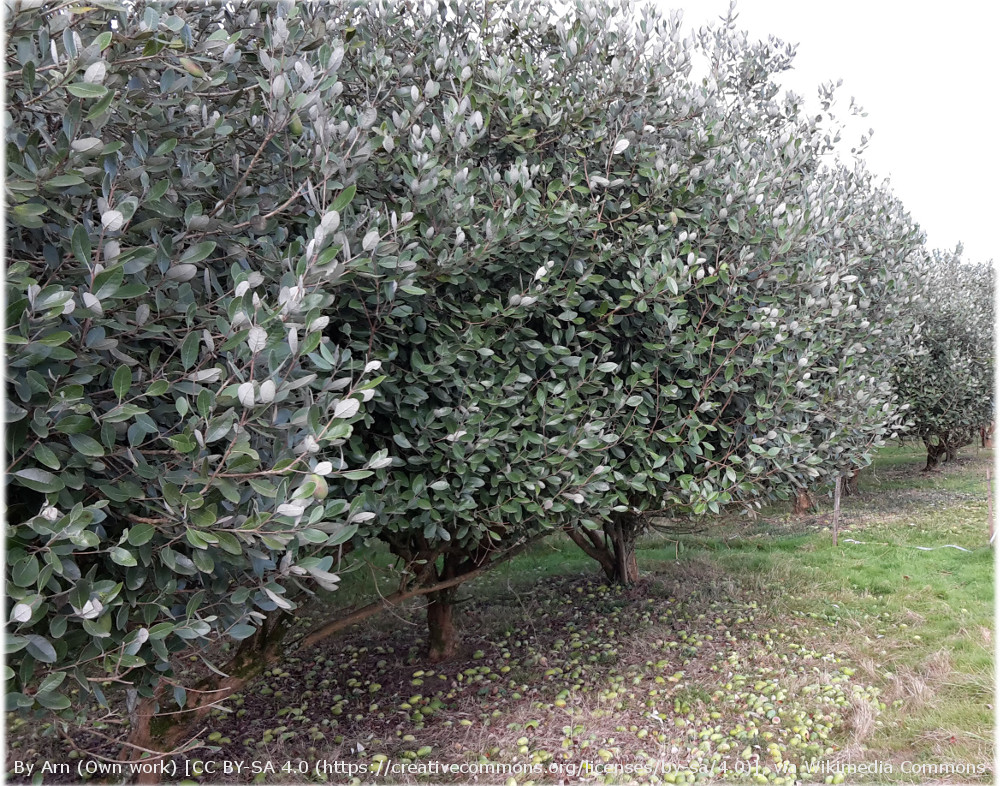By Adam Idoine
 My childhood in New Zealand was punctuated every autumn by a bounty of a sweet, fragrant fruit called feijoas. Our garden, like many of our neighbours’ contained a couple of non-descript evergreen shrubs. Every summer they would develop a display of small white flowers with fleshy petals and brilliant red stamens, promising a bumper crop of egg-shaped green fruit for the coming autumn, as long as its pollinators: bees and small birds, do their job. When autumn came, the fruit would drop to the ground, where I’d have to be quick to harvest them by the bucketful every few days before they began to rot.
My childhood in New Zealand was punctuated every autumn by a bounty of a sweet, fragrant fruit called feijoas. Our garden, like many of our neighbours’ contained a couple of non-descript evergreen shrubs. Every summer they would develop a display of small white flowers with fleshy petals and brilliant red stamens, promising a bumper crop of egg-shaped green fruit for the coming autumn, as long as its pollinators: bees and small birds, do their job. When autumn came, the fruit would drop to the ground, where I’d have to be quick to harvest them by the bucketful every few days before they began to rot.

The fruit has a leathery green skin, and a juicy flesh, which contains a gooey, transparent seed pulp and a whitish, opaque flesh. The entire fruit is edible, although typically only the internal flesh is eaten. The flavour is difficult to explain; it has strong flavours reminiscent of pineapple, guava and pear (many of which come from the ester methyl benzoate). I’ve heard it described as like eating a pineapple just after brushing your teeth, although I promise you it’s more delicious than that makes it sound.

The feijoa is native to South America – where it naturally grows from southern Brazil to northern Argentina. They are grown commercially in Australia, Azerbaijan, South America and New Zealand, and they grow with varying success in private gardens all over the world from Scotland to California, USA. Their export market is relatively untapped because they travel extremely poorly – because of this, imported feijoas often sell for several dollars each (and just aren’t the same as a fresh one from the garden). Commercial products containing feijoa are produced, though, such as chocolate, juice, and flavoured vodka (which makes an amazing “New Zealand mule” cocktail with ginger beer).

There’s been a boost in research in A. sellowiana since the turn of the century. Pollination and development had been studied for decades, but recently there has been a new era of feijoa research – in crop improvement, and to deal with issues around diseases and pests which damage feijoa crops. There’s even work into compounds in feijoa fruit which appear to have an antimicrobial effect.
With advances through these studies, varieties suited to a broader range of environments, and producing more transportable fruit, will no doubt be developed, so look out for some weird egg-shaped fruits in a supermarket near you!
About the author

Adam is a postdoc at the Carnegie Institution, Stanford, where he works on developing molecular biology tools to study various non-model-organism algae. In particular, he’s an expert in transformation, genome editing, transcriptomics and organelle biology. He’s also really enthusiastic about science outreach and communication. He’s currently open to opportunities in the biotech/startup world. In his spare time, he enjoys indoor rock climbing, meet interesting people, and spend time outdoors.
Editor’s note
This plant, sometimes known as the pineapple Guava, from Brazil and Argentina is moderately cold tolerant and can be grown outside in mild areas of the UK. We grow this in a frost free greenhouse at University of Reading.

